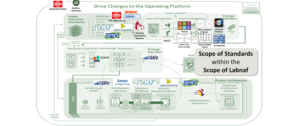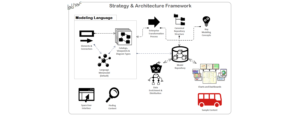Why an all-in-one and unified process for driving transformations?
- Because you want to focus on business outcomes
- To enable cross-discipline collaboration
- To make your enterprise operating model visible for today and for the future
- To better understand your internal business context thanks to your visible enterprise description
- To turn “strategy to execution” from promises to reality
- To review your business model and strategic objectives based on a defined business context
- To derive target capabilities and project roadmaps from SMART goals
- To derive required solution architecture capacity from strategic planning and roadmapping.
- To clearly know why and when you need to start THIS project
- To enable practical governance at each step of the digital transformations
- To take better decisions knowing the implications
- To save you years of expensive efforts making your own process
- To start digital transformations from day one
- …
The process needs to indicate clearly what is to be delivered throughout the process. So, the process is better expresses as a flow of viewpoints. i.e. the types of views that needs to be delivered by roles throughout the process.
And to make the process really actionable, it is needs to come with some scalable tools and repository structure.
Here is a video that takes you through the Labnaf process of driving transformations, step by step.
What is the scope of the Labnaf process of driving transformations?
If you take the IT4IT framework as a reference, here is how the Labnaf process maps to the IT Value Chain. The process of driving transformations corresponds to the first step in this IT Value Chain. IT4IT calls this first step “Strategy to Portfolio”.
How to create a process with such a large scope?
The following picture shows some of the key standards and best practices that were semantically merged.
Labnaf merges and extends a selection of meaningful and useful concepts into one single process, language, database, and software.
A term is meaningful when it is needed somewhere in the process, and more particularly in some viewpoints that the process orchestrates, as in this sample scenario.
These meaningful concepts were precisely integrated in a conceptual metamodel. And to make sure that this conceptual metamodel also makes sense with generic systems semantics.
The Labnaf language metamodel is directly derived from the conceptual metamodel. It covers the entire scope that includes, notably, enterprise architecture, strategic planning and solution architecture.
This short video provides further explanations.

The Labnaf Guidance web site describes the process in several formats, including models, video, slide deck and Word document.





